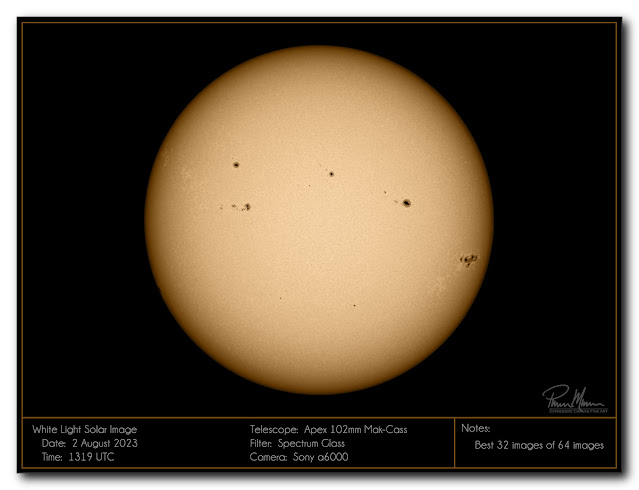Short Solar Session
When I got up this morning, I immediately noticed that the sun was streaming in our windows and it was a color of light that we haven't seen in quite a while. It took me a few seconds to recognized it but it was normal, bright sunshine not discolored nor diffused by smoke! When I peered out the window, I noticed that the sky was a nice blue! My first thoughts were that I should take advantage of the rare good weather to do some solar astronomy.
Unfortunately, my spine still has not fully recovered from my latest spinal problems that left me crumpled on the bathroom floor a few days ago. This meant that I would need to keep my astronomy gear to a minimum to limit the amount of gear I would need to lift and carry outside. So, I decided to go back to basics with simple gear.
I chose my smallest telescope (physical size)... my Apex 102mm Maksutov-Cassegrain. I chose my simplest solar filter which is a glass filter that mounts on the front of the telescope. I chose a tiny solar finder scope. I chose a small diagonal and a single eyepiece. Solar astronomy can get very complicated very quickly with specialized gear, heavy mounts, specialized filters, cables and a computer but this kit I put together this morning was very simple and very light.
After observing for about 15 minutes, I went inside to retrieve my small Sony a6000 camera body. I figured this would be the easiest way to capture an image of what I was seeing. My astronomy cameras would require a laptop computer which also means a small table for the laptop and a light shield so I would be able to see the LCD screen. I opted to just swap my eyepiece for my Sony a6000 camera body and shoot some quick photos that way instead of setting up a computer. Adding the computer makes things a bit more complicated but I wanted to keep things light and simple.
The seeing was pretty good this morning too (the view was steady). The sun was looking quite crisp. Before bringing this small solar astronomy kit back inside, I shot a few photos with my Sony a6000 camera...
The photo clearly shows quite a few sunspots. Sunspots are relatively cooler (approximately 6000°F) than the surrounding plasma (approximately 10,000-14,000°F) which is why they appear black. Our sun is a big nuclear fusion reactor that fuses hydrogen into helium.
These relatively cooler sunspots are sources of flares and coronal mass ejections. Concentrations of magnetic field lines collect from deep within the sun into the sunspots and then arc out of the sunspots and around the sunspot active regions. In the right light (not the light I imaged here), these magnetic field lines can be seen being emitted from these sunspots too. (I've imaged this before in hydrogen alpha light.)
In this image we can also see lighter/whiter areas of fine detail which are faculae. Faculae are also areas of magnetic activity but these magnetic bundles are smaller than those seen in sunspots.
Also, if we look at the fainter fine detail on the surface, we can see very tiny dots which is granulation of the photosphere. Granulation is cells of plasma bubbling to the surface. Each of those faint tiny dots of granulation are actually the approximate size of Texas. Each granulation cell lasts only about 20 minutes as the plasma bubbles to the top of each cell on the surface of the photosphere. In this type of solar imaging, above, we are seeing the tops of these deep cells.
The sunspot toward the center of the solar sphere here in this photo is approximately the size of Earth. The diameter of the sun is 109 times larger than the diameter of Earth.
Within a few minutes after shooting a series of photos to compile into the above image, the sky was overcast. On the positive side, I was able to squeeze in a short solar astronomy session this morning and capture a nice image of what I observed.

Comments
Post a Comment